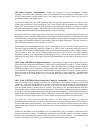25
power to stay around an input power of 0 dbm to our HP3686 to stay well within its accurate measuring
range of +20dbm to –100dbm.
The best way to do this and since we are dealing with low power, is to insert a 20db 50 ohm attenuator pad
between the 150 ohm resistor and the amplifier’s input. We remove the amplifier and insert the attenuator
between the resistors in place of the amplifier. We now repeat the normalization procedure of section 14.3
at an instrument frequency of 14MHz to obtain a 0db reading with the offset enabled with only the
attenuator and terminating resistors in the line.
Finally we reinstall the amplifier between the output of the 20db attenuator and with its output to the 50
ohm resistor. We leave the frequency of our HP3586 at 14MHz and power up our amplifier. We now see
a reading of 20.13db on the instrument’s level display indicating its gain. We now can tune the
instrument’s frequency between 14MHz and 30MHz and take gain readings of from 19.43db to 23.37db
indicating a good flat response near 20db of gain over our required bandwidth.
This example illustrates the use of the HP3586 is an excellent tool for network analysis because of its
internal stable tracking oscillator with the outboard attenuator being a signal generator and selective
detector.
14.6 Alignment and Analysis of Radio Circuits - A HP3586 could also be used to aid in alignment,
measuring gain or troubleshooting a receiver’s RF amplifier or IF circuits. It can do this because it’s a
selective detector that can measure low power level signals between 200KHz and 32MHz along with
having a tracking oscillator tuned exactly to the detector’s frequency that can be used as an input to drive a
circuit. Here I’ll just suggest some ideas and considerations and leave the details to you.
If you use the HP3586’s tracking oscillator to drive RF or IF circuits remember the oscillator is always at
the detector’s frequency so you can’t go into a mixer stage and change frequency and then detect it at a
different frequency. If you want to check the performance of a mixer, you’ll have to use a separate
oscillator. Also since the tracking oscillator is fixed at 1 mw output, 0dbm, you’ll need some attenuator
pads to control it’s output level into very low power circuits. A fixed –60db pad with a –20db pad
adjustable in 3db steps will work fine for reducing the Fo output for receiver inputs. I built one from film
resistor using design information in the ARRL handbook. You can also look at the signal out of the
attenuators to accurate know it’s level using the HP3586’s input and selective level measuring detector.
Since the HP3586’s oscillator’s output impedance is low, 75 ohms, and input impedance can be 50, 75, or
10K ohms it should be able to easily match it’s impedances to low impedance solid state circuits. However
when analyzing the high impedances usually found in tube amplifier circuits, you may need a method of
isolating the instrument from the circuit. In measuring gain or aligning RF amplifier stages of a tube type
receiver, feeding the signal from the HP3586 shouldn’t be a problem since these radio’s usually have a 50
antenna ohm input, but matching to the mixer end of the RF amplifier can be a problem. But you could use
one of the isolation amplifier designs from Appendix C to do this at the grid of the mixer tube to not load
and detune the mixer input circuit.
When introducing a IF signal into an IF strip and not to detuning the mixer output circuit, you can usually
do this by introducing the tracking oscillator’s low impedance signal at the grid of the mixer tube before
the IF strip. This should work fine since the IF frequency signal should go through the mixer and the mixer
tube will isolate the first IF circuit from the oscillator. This is the method usually recommended in receiver
repair manuals for introducing a signal to align IF stages.


















